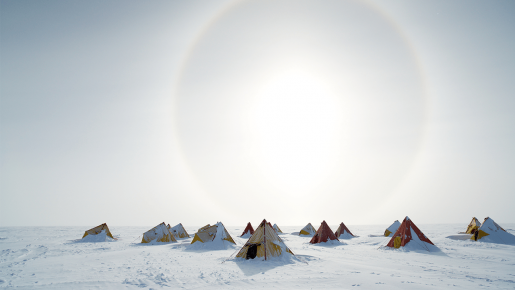The Coldest Continent on Earth: An Analog for Space Health Research?
Imagine living in Antarctica for months in extreme temperatures, far from friends and family and largely cut off from outside help over the dark winter months. This situation would challenge anyone’s mental health.
It is a perfect analogy for conducting behavioral health research on astronauts and commercial space travelers and understanding the challenges of providing medical care given extreme constraints, because the environment in Antarctica is similar to space.

The Australian Antarctic Division (AAD), part of the Australian government, operates three isolated research stations in the polar region and one on Macquarie Island in the southwestern Pacific Ocean.
Thanks to a new agreement between Baylor College of Medicine’s Center for Space Medicine (CSM) and AAD, an international collaboration for space health research between the Center’s Translational Research Institute for Space Health (TRISH) and AAD’s Polar Medicine Unit, named the Australian Antarctic Space Analog (AASA), has initiated two projects looking at training to acquire medical imaging, and body composition changes.
Crews working at some AAD stations experience a unique “winter over,” extending for up to nine months, where they are isolated from the rest of the world. Traditional stations in Antarctica have a team of physicians and medical professionals at each station to provide medical care, but the AAD has been using a single physician model across their stations for decades. This model closely resembles the concept of operations that missions to the moon and beyond will utilize.
Stations within the AAD have small crews of about 12-14 people, especially during the “winter over.” While these crews are highly screened and cross-trained to ensure safe and reliable operations, mental health is still a concern.
The collaboration between AAD and CSM/TRISH will outline priorities and select new projects for consideration in the coming months for the program’s 2025 Winter Over. Proposals addressing behavioral challenges associated with extreme isolation and the need to develop advanced autonomous medical care for long-duration space travel are of specific interest. A pilot project deployed by TRISH in 2022 to multiple AAD stations and Antarctic resupply ships tests the use of a miniaturized ultrasound probe called Butterfly IQ+. The AI-guided probe helps physicians and crew members with no medical experience develop optimal clinical-grade image acquisition.
In addition, an ongoing project looking at measuring body composition changes without the requirement of radiation and larger equipment has been deployed with TRISH support.
CSM/TRISH is also involved in Australia’s Million Year Ice Core project, which aims to collect and extend a detailed record of Earth’s climate history. The project will provide a real-life, Earth-based platform to test how medical operations can be conducted in an Artemis-like scenario and teach users how to improve communications and processes throughout the mission.
The CSM-TRISH-AAD collaboration will highlight a continuous collaboration between the two entities for a sustained period, paving the way for long-term space health research to facilitate future missions.
Space travel can be physically and mentally challenging for astronauts and private space travelers, requiring practical solutions to ensure their well-being during and after missions. Findings from this collaboration will lead to new health and performance diagnostics and countermeasures that may lead to meaningful health advances for NASA’s future trips to the moon and Mars and on upcoming commercial space flights, as well as new solutions for Earth-based medical care.
The products developed and matured through this collaboration could also be relevant to addressing the challenges of delivering healthcare to remote communities on Earth. Findings from this research will help address healthcare needs in isolated areas or places with limited resources. This can lead to breakthroughs in healthcare access for remote or underserved communities and long-term improvements in global healthcare.
This Baylor CSM partnership with AAD reflects the innovative possibilities of collaborating with other government organizations and agencies. Transcending international borders allows for the transcendence of borders in research, especially for furthering space health research and human exploration.
By Shivani Persaud, communications fellow for the Translational Research Institute for Space Health within the Center for Space Medicine



